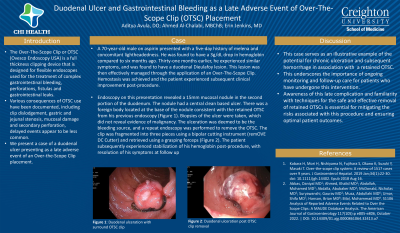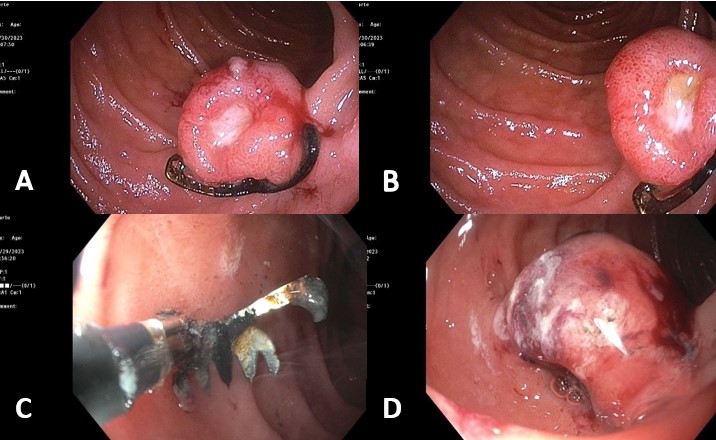Sunday Poster Session
Category: Interventional Endoscopy
P1121 - Duodenal Ulcer and Gastrointestinal Bleeding as a Late Adverse Event of Over-The-Scope Clip (OTSC) Placement
Sunday, October 27, 2024
3:30 PM - 7:00 PM ET
Location: Exhibit Hall E

Has Audio

Aditya V. Avula, DO
Creighton University School of Medicine
Rochester, MN
Presenting Author(s)
Aditya V. Avula, DO1, Ahmad Al-Chalabi, MBChB2, Erin Jenkins, MD1
1Creighton University School of Medicine, Omaha, NE; 2CHI Health Creighton University Medical Center, Omaha, CA
Introduction: The Over-The-Scope Clip (OTSC) is a full thickness clipping device that is designed for flexible endoscopes that are used for the treatment of complex gastrointestinal bleeding, perforations, fistulas and gastrointestinal leaks. While various consequences of OTSC use, including clip dislodgement, gastric and jejunal stenosis, mucosal damage and secondary perforation have been documented, delayed events appear to be less common. We present a case of a duodenal ulcer presenting as a late adverse event of an Over-the-Scope-Clip placement.
Case Description/Methods: A 70-year-old male on aspirin presented with a five-day history of melena and concomitant lightheadedness. He was found to have a hemoglobin of 9.6 g/dL, decreased from 13.2 g/dL six months prior. Thirty-one months earlier, he experienced similar symptoms, and was found to have a duodenal Dieulafoy lesion. This lesion was then effectively managed through the application of an OTSC. Hemostasis was achieved and the patient experienced subsequent clinical improvement post-procedure.
Endoscopy on this presentation revealed a 15mm mucosal nodule in the second portion of the duodenum (Figure A). The nodule had a central clean based ulcer. There was a foreign body located at the base of the nodule consistent with the retained OTSC from his previous endoscopy (Figure B). Biopsies of the ulcer were taken, which did not reveal evidence of malignancy. The ulceration was deemed to be the bleeding source, and a repeat endoscopy was performed to remove the OTSC. The clip was fragmented into three pieces using a bipolar cutting instrument (remOVE DC Cutter) and retrieved using a grasping forceps (Figure C and D). The patient subsequently experienced stabilization of his hemoglobin post-procedure. At a follow up appointment two months later, he denied any further melena with a complete blood count confirming normalization of his hemoglobin.
Discussion: This case serves as an illustrative example of the potential for chronic ulceration and subsequent hemorrhage in association with a retained OTSC. It underscores the importance of ongoing monitoring and follow-up care for patients who have undergone this intervention. Awareness of this late complication and familiarity with techniques for the safe and effective removal of retained OTSCs is essential for mitigating the risks associated with this procedure and ensuring optimal patient outcomes.

Disclosures:
Aditya V. Avula, DO1, Ahmad Al-Chalabi, MBChB2, Erin Jenkins, MD1. P1121 - Duodenal Ulcer and Gastrointestinal Bleeding as a Late Adverse Event of Over-The-Scope Clip (OTSC) Placement, ACG 2024 Annual Scientific Meeting Abstracts. Philadelphia, PA: American College of Gastroenterology.
1Creighton University School of Medicine, Omaha, NE; 2CHI Health Creighton University Medical Center, Omaha, CA
Introduction: The Over-The-Scope Clip (OTSC) is a full thickness clipping device that is designed for flexible endoscopes that are used for the treatment of complex gastrointestinal bleeding, perforations, fistulas and gastrointestinal leaks. While various consequences of OTSC use, including clip dislodgement, gastric and jejunal stenosis, mucosal damage and secondary perforation have been documented, delayed events appear to be less common. We present a case of a duodenal ulcer presenting as a late adverse event of an Over-the-Scope-Clip placement.
Case Description/Methods: A 70-year-old male on aspirin presented with a five-day history of melena and concomitant lightheadedness. He was found to have a hemoglobin of 9.6 g/dL, decreased from 13.2 g/dL six months prior. Thirty-one months earlier, he experienced similar symptoms, and was found to have a duodenal Dieulafoy lesion. This lesion was then effectively managed through the application of an OTSC. Hemostasis was achieved and the patient experienced subsequent clinical improvement post-procedure.
Endoscopy on this presentation revealed a 15mm mucosal nodule in the second portion of the duodenum (Figure A). The nodule had a central clean based ulcer. There was a foreign body located at the base of the nodule consistent with the retained OTSC from his previous endoscopy (Figure B). Biopsies of the ulcer were taken, which did not reveal evidence of malignancy. The ulceration was deemed to be the bleeding source, and a repeat endoscopy was performed to remove the OTSC. The clip was fragmented into three pieces using a bipolar cutting instrument (remOVE DC Cutter) and retrieved using a grasping forceps (Figure C and D). The patient subsequently experienced stabilization of his hemoglobin post-procedure. At a follow up appointment two months later, he denied any further melena with a complete blood count confirming normalization of his hemoglobin.
Discussion: This case serves as an illustrative example of the potential for chronic ulceration and subsequent hemorrhage in association with a retained OTSC. It underscores the importance of ongoing monitoring and follow-up care for patients who have undergone this intervention. Awareness of this late complication and familiarity with techniques for the safe and effective removal of retained OTSCs is essential for mitigating the risks associated with this procedure and ensuring optimal patient outcomes.

Figure: Endoscopic view of duodenal ulceration before and after OTSC clip removal
Disclosures:
Aditya Avula indicated no relevant financial relationships.
Ahmad Al-Chalabi indicated no relevant financial relationships.
Erin Jenkins indicated no relevant financial relationships.
Aditya V. Avula, DO1, Ahmad Al-Chalabi, MBChB2, Erin Jenkins, MD1. P1121 - Duodenal Ulcer and Gastrointestinal Bleeding as a Late Adverse Event of Over-The-Scope Clip (OTSC) Placement, ACG 2024 Annual Scientific Meeting Abstracts. Philadelphia, PA: American College of Gastroenterology.
